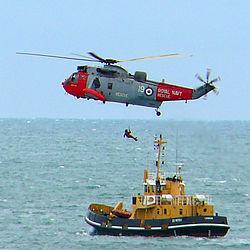
A coast guard or coastguard is a maritime security organization of a particular country. The term embraces wide range of responsibilities in different countries, from being a heavily armed military force with customs and security duties to being a volunteer organization tasked with search and rescue without law enforcement authority. In most countries, a typical coast guard's functions are distinct from those of the navy and the transit police, while in certain countries they have similarities to both.

Search and rescue (SAR) is the search for and provision of aid to people who are in distress or imminent danger. The general field of search and rescue includes many specialty sub-fields, typically determined by the type of terrain the search is conducted over. These include mountain rescue; ground search and rescue, including the use of search and rescue dogs ; urban search and rescue in cities; combat search and rescue on the battlefield and air-sea rescue over water.
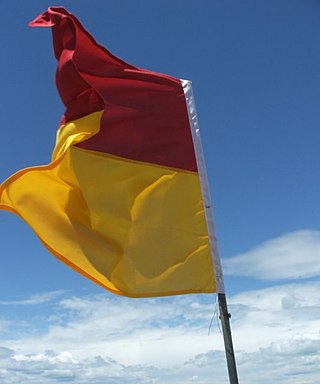
A lifeguard is a rescuer who supervises the safety and rescue of swimmers, surfers, and other water sports participants such as in a swimming pool, water park, beach, spa, river and lake. Lifeguards are trained in swimming and CPR/AED first aid, certified in water rescue using a variety of aids and equipment depending on requirements of their particular venue. In some areas, lifeguards are part of the emergency services system to incidents and in some communities, lifeguards may function as the primary EMS provider.
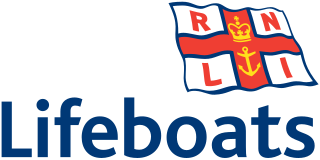
The Royal National Lifeboat Institution (RNLI) is the largest of the lifeboat services operating around the coasts of the United Kingdom, the Republic of Ireland, the Channel Islands, and the Isle of Man, as well as on some inland waterways.
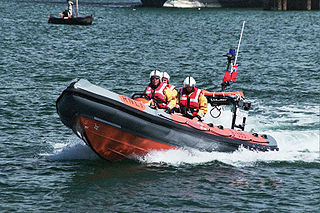
A rigid inflatable boat (RIB), also rigid-hull inflatable boat or rigid-hulled inflatable boat (RHIB), is a lightweight but high-performance and high-capacity boat constructed with a rigid hull bottom joined to side-forming air tubes that are inflated with air to a high pressure so as to give the sides resilient rigidity along the boat's topsides. The design is stable, light, fast and seaworthy. The inflated collar acts as a life jacket, ensuring that the vessel retains its buoyancy, even if the boat is taking on water. The RIB is an evolutionary development of the inflatable boat with a rubberized fabric bottom that is stiffened with flat boards within the collar to form the deck or floor of the boat.
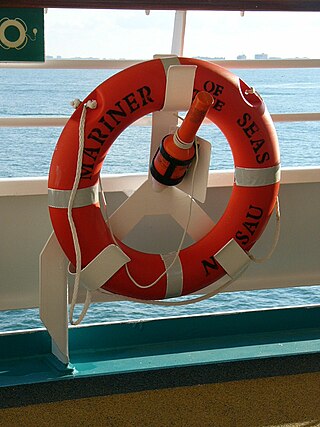
A lifebuoy is a life-saving buoy designed to be thrown to a person in water to provide buoyancy and prevent drowning. Some modern lifebuoys are fitted with one or more seawater-activated lights to aid rescue at night.

A rescue craft is a boat, ship or aircraft used in rescuing.
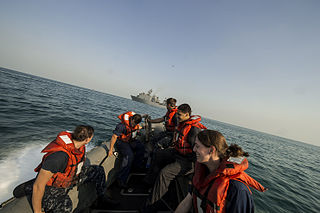
A personal flotation device is a flotation device in the form of a vest or suit that is worn by a user to prevent the wearer from drowning in a body of water. The device will keep the wearer afloat with their head and mouth above the surface – they do not have to swim or tread water in order to stay afloat and can even be unconscious.

The International Life Saving Federation (ILS) is an organisation for drowning prevention, water safety, lifesaving and lifesaving sports.

Air-sea rescue, and aeronautical and maritime search and rescue (AMSAR) by the ICAO and IMO, is the coordinated search and rescue (SAR) of the survivors of emergency water landings as well as people who have survived the loss of their seagoing vessel. ASR can involve a wide variety of resources including seaplanes, helicopters, submarines, rescue boats and ships. Specialized equipment and techniques have been developed. Both military and civilian units can perform air-sea rescue. Its principles are laid out in the International Aeronautical and Maritime Search and Rescue Manual. The International Convention on Maritime Search and Rescue is the legal framework that applies to international air-sea rescue.

Lifesaving is the act involving rescue, resuscitation and first aid. It often refers to water safety and aquatic rescue; however, it could include ice rescue, flood and river rescue, swimming pool rescue and other emergency medical services. Lifesaving also refers to sport where lifesavers compete based on skills, speed and teamwork. Lifesaving activities specialized in oceanic environment is called surf lifesaving or coastal lifesaving.

An able seaman (AB) is a seaman and member of the deck department of a merchant ship with more than two years' experience at sea and considered "well acquainted with his duty". An AB may work as a watchstander, a day worker, or a combination of these roles. Once a sufficient amount of sea time is acquired, then the AB can apply to take a series of courses/examinations to become certified as an officer.

A lifeboat or liferaft is a small, rigid or inflatable boat carried for emergency evacuation in the event of a disaster aboard a ship. Lifeboat drills are required by law on larger commercial ships. Rafts (liferafts) are also used. In the military, a lifeboat may double as a whaleboat, dinghy, or gig. The ship's tenders of cruise ships often double as lifeboats. Recreational sailors usually carry inflatable liferafts, though a few prefer small proactive lifeboats that are harder to sink and can be sailed to safety.
A rescue lifeboat is a boat rescue craft which is used to attend a vessel in distress, or its survivors, to rescue crew and passengers. It can be hand pulled, sail powered or powered by an engine. Lifeboats may be rigid, inflatable or rigid-inflatable combination-hulled vessels.
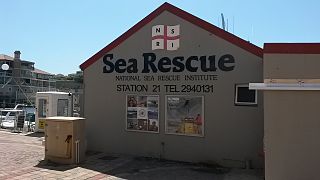
The National Sea Rescue Institute (NSRI) is a voluntary non-profit organisation in South Africa tasked with saving lives through drowning prevention. It operates 49 bases comprising coastal stations, inland stations on dams, auxiliary stations and lifeguard units. There are crews on standby at all hours. There are over 1000 volunteers equipped with sponsored rescue craft, rescue vehicles, quad bikes and tractors, supported by an operations department at the head office.
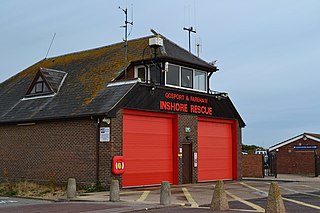
Gosport Lifeboat Station is a volunteer-operated independent lifeboat station charity located in the village of Alverstoke on the peninsula of Gosport in the English county of Hampshire. Owned and operated by Gosport and Fareham Inshore Rescue Service (GAFIRS), it operates free lifeboat services in the Solent from Portsmouth Harbour to Titchfield Haven, on the approaching shores of Southampton Water. GAFIRS is a charity registered in England and Wales (1159681).
The Directorate General of Coastal Safety has been established by the Turkish Republic Council Of Ministers’ decision on 12 May 1997 as a General Directorate and State owned Organization. The mission of the foundation is to assist and improve the safety of navigation in Turkish Waters. The organization’s core competences are:

Jersey Coastguard is responsible for the safety of life at sea along with the security and protection of the maritime environment for Jersey’s territorial waters. The service is provided by the Ports of Jersey from the Maritime Operations Centre in Maritime House in the port of St Helier, Jersey.

The Marine Branch (1918–1986) was a branch of the Royal Air Force (RAF) which operated watercraft in support of RAF operations. Just days after the creation of the RAF itself, the Marine Craft Section (MCS) was created with the transfer of Royal Naval Air Service (RNAS) vessels and personnel to the new service. Originally tasked with the support of RNAS, and later RAF, seaplanes, Marine Craft Section was to achieve its greatest size during the Second World War, and achieved fame for its role in air-sea rescue operations. After the war MCS was granted full branch status on 11 December 1947; however, post-war the role of the new branch became greatly reduced with the end of the British Empire, the withdrawal of flying boats from service, and the increasing use of helicopters in air-sea rescue. The branch was disestablished on 8 January 1986.
On 24 November 2021, an inflatable dinghy carrying migrants from France to the United Kingdom capsized in the English Channel causing the deaths of 27 of the 30 people on board. It is believed to be the deadliest incident in the English Channel since the International Organization for Migration began collecting data in 2014.
